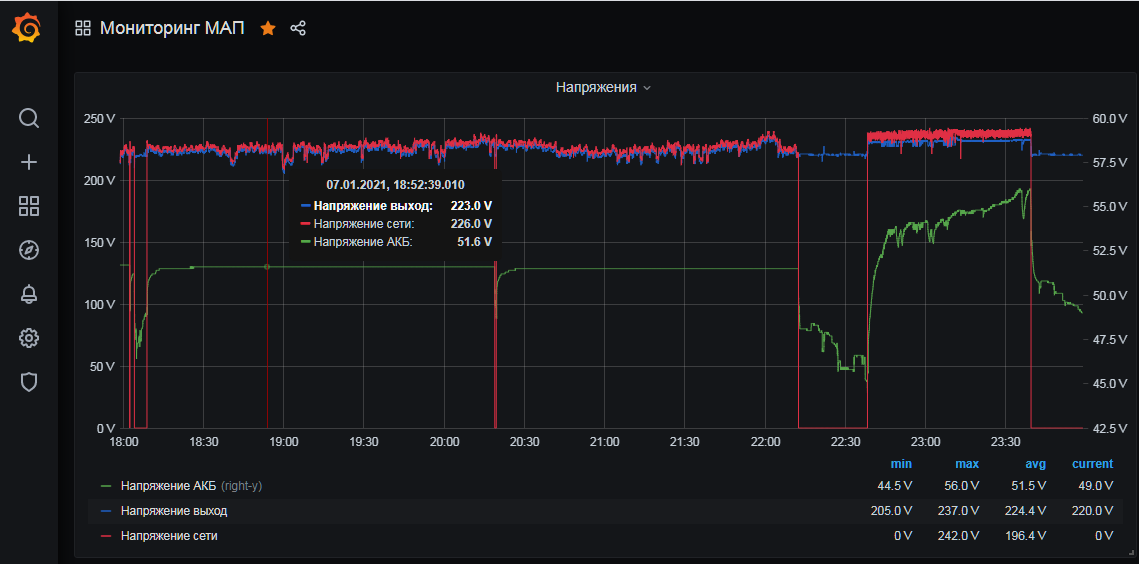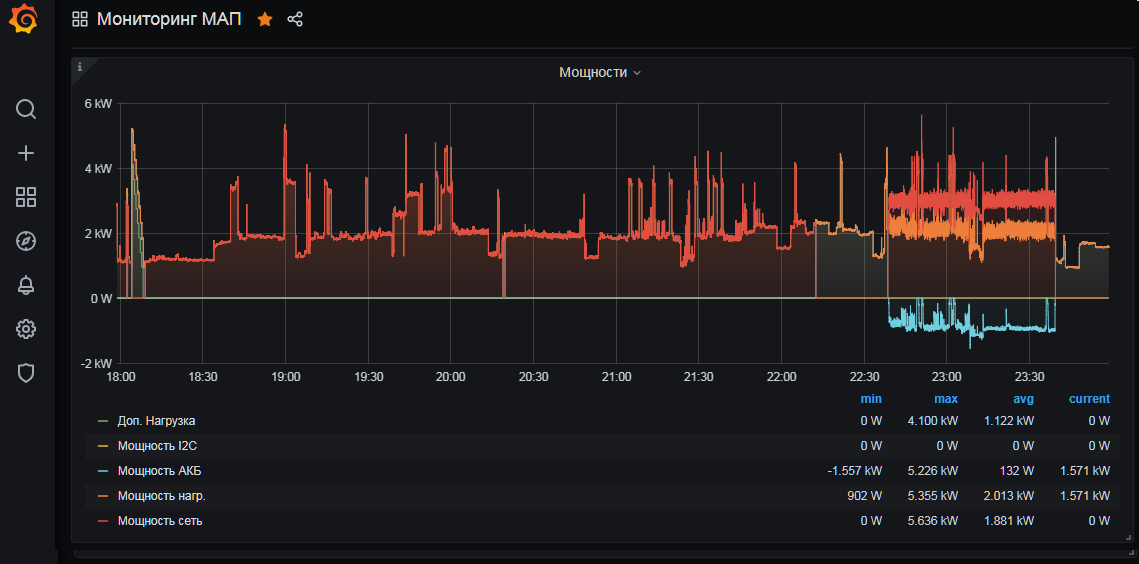Introductory. Why did I need it
Personally, I needed to organize monitoring of a home solar power plant.
Briefly about the hardware (although this post is not about it):
Inverter MAC Energy and 3 solar controllers from the same manufacturer.
A microcomputer is installed inside the inverter (the manufacturer calls it "Malina"), which is able to do something in terms of monitoring, but not everything that I need, and not very convenient. The value of the microcomputer is that it takes data from the com-ports of the inverter and controllers and publishes it to its http server as Json. The web services data is refreshed approximately every second. There are also web services for managing the relays built into the controllers and the inverter.
A couple of SR-201 Ethernet devices are such boards with relays, used for load control and something else, controlled via tcp and udp protocols.
Home server running Centos-8, Oracle is installed on it (of course Express Edition with all its limitations, but enough for a home server)
There are 2 JOBs running in the oracle (in fact, these are persistent processes that spin an endless loop and restart about once every half hour):
Once a second, it removes data from the Malina web services, the current state of the SR-201 devices relay and writes it all to the Oracle database. Removes from Raspberry using simple functions based on utl_http, from reyukh - through utl_tcp. Actually, this is the statistics that we will monitor.
Constantly recalculates statistics for a certain period of time, and based on the results obtained, it controls the load and something else through the SR-201 and the built-in relays of the inverter and controllers.
. ( Job2), , . "" - , - ( SR-201 ), - - , - .
: Oracle Postgres ? , ... :-)
Grafana https://grafana.com - . , . ...
tutorial, , .
:
grafana
$ sudo nano /etc/yum.repos.d/grafana.repo
[grafana]
name=grafana
baseurl=https://packages.grafana.com/oss/rpm
repo_gpgcheck=1
enabled=1
gpgcheck=1
gpgkey=https://packages.grafana.com/gpg.key
sslverify=1
sslcacert=/etc/pki/tls/certs/ca-bundle.crt
dnf update
dnf install grafana
systemctl daemon-reload
systemctl enable --now grafana-server
systemctl status grafana-server
Selinux , ,
: Grafana Oracle , () Enterprise , 24$ . grafana-simple-json-datasource
grafana-cli plugins install grafana-simple-json-datasource
systemctl restart grafana-server
. , - .
apache + php
:
httpd, php php-fpm ( php 7.2) freepbx :-)
php oci8 - , php 7.2 oci8 pecl.
:
remi, :
dnf install php-pecl-oci8
oci8 php
/etc/hp.d/20-oci8.ini
1
extension=oci8.so
oci8 ,
/etc/php-fpm.d/www.conf
env[ORACLE_HOSTNAME] = myserver.localdomain
env[ORACLE_UNQNAME] = mydb
env[ORACLE_BASE] = /u01/app/oracle
env[ORACLE_HOME] = /u01/app/oracle/product/18.4.0/dbhome_1
env[ORA_INVENTORY] = /u01/app/oraInventory
env[ORACLE_SID] = mydb
env[LD_LIBRARY_PATH] = /u01/app/oracle/product/18.4.0/dbhome_1/lib:/lib:/usr/lib
env[NLS_LANG] = AMERICAN_CIS.UTF8
php- , oci8
/var/www/html/gr/gr.php
<?php
header("Content-Type: application/json;");
$conn = oci_pconnect('www', 'www$password', 'mydb', 'AL32UTF8');
if (!$conn) {
$e = oci_error();
trigger_error(htmlentities($e['message'], ENT_QUOTES), E_USER_ERROR);
}
//
$stid = oci_parse($conn, 'begin LGRAFANA.GetJson(:vPath, :vInp, :vOut); end;');
if (!$stid) {
$e = oci_error($conn);
trigger_error(htmlentities($e['message'], ENT_QUOTES), E_USER_ERROR);
}
//
$vInp = oci_new_descriptor($conn, OCI_DTYPE_LOB);
$vOut = oci_new_descriptor($conn, OCI_DTYPE_LOB);
//
$vPath = $_SERVER["PATH_INFO"];
$postdata = file_get_contents("php://input");
$vInp->writeTemporary($postdata, OCI_TEMP_BLOB);
oci_bind_by_name($stid, ":vPath", $vPath);
oci_bind_by_name($stid, ":vInp", $vInp, -1, OCI_B_BLOB);
oci_bind_by_name($stid, ":vOut", $vOut, -1, OCI_B_BLOB);
//
$r = oci_execute($stid);
if (!$r) {
$e = oci_error($stid);
trigger_error(htmlentities($e['message'], ENT_QUOTES), E_USER_ERROR);
}
echo $vOut->load();
$vInp ->close();
$vOut ->close();
oci_free_statement($stid);
oci_commit($conn);
oci_close($conn);
?>
.
LGRAFANA,
procedure GetJson(pPathInfo in varchar2, pInpPost in blob, pOutPost out blob);
Json - . , , Json -
https://grafana.com/grafana/plugins/grafana-simple-json-datasource
Now the setting in the grafana itself:
Configuration - Data Sources - Add DataSource - Simple JSON

Then you can go to add DashBoard and throw panels with the necessary charts there
... If you already have an implementation of the LGRAFANA package, of course.
By the way, about the package.
Briefly like this:
We implement a method that reacts to pahinfo = / search and returns an array of metric names that we can count
We implement the / query method that forms an array of data for the required metrics
Full package text
CPALL varchar2(30) := ' .';
CPNET varchar2(30) := ' ';
CPACB varchar2(30) := ' ';
CPI2C varchar2(30) := ' I2C';
CPADD varchar2(30) := '. ';
CPMP1 varchar2(30) := ' MPPT1';
CPMP2 varchar2(30) := ' MPPT2';
CPMP3 varchar2(30) := ' MPPT3';
CEDAY varchar2(30) := ' ';
CEMP1 varchar2(30) := ' MPPT1';
CEMP2 varchar2(30) := ' MPPT2';
CEMP3 varchar2(30) := ' MPPT3';
CETOB varchar2(30) := ' ';
CEFRB varchar2(30) := ' ';
CEFRN varchar2(30) := ' ';
CUNET varchar2(30) := ' ';
CUOUT varchar2(30) := ' ';
CUACB varchar2(30) := ' ';
function TsToUTs(v_Ts in timestamp) return number is
v_Dt date;
begin
v_Dt := v_ts;
return trunc((v_Dt - to_date('01.01.1970','DD.MM.YYYY')) -- - 1 1970
* (24 * 60 * 60)) -- -
* 1000 --
+ to_number(to_char(v_ts,'FF3')); --
end;
procedure get_query(pInp in out nocopy JSON_OBJECT_T, pOut in out nocopy JSON_ARRAY_T) is
type rtflag is record (
fTp varchar2(30)
,fOb json_object_t
,fAr json_array_t
);
type ttflag is table of rtflag index by varchar2(127);
tflag ttflag;
vTmpOb json_object_t;
vTmpAr json_array_t;
vTmpId varchar2(30);
vDBeg timestamp;
vDEnd timestamp;
vDDBeg date;
vDDEnd date;
num_tz number;
curts number;
function GetFlag(pFlagName in varchar2) return boolean is
begin
if tflag.exists(pFlagName) then
return true;
else
return false;
end if;
end;
--function GetFlagType(pFlagName in varchar2) return varchar2 is
--begin
-- if tflag.exists(pFlagName) then
-- return tflag(pFlagName).fTp;
-- else
-- pragma error(' ['||pFlagName||'] tflag');
-- end if;
--end;
procedure AddTrgData(pTrgName in varchar2, pStamp in number, pValue in number) is
begin
vTmpAr := Json_Array_t;
vTmpAr.append(pValue);
vTmpAr.append(pStamp);
tFlag(pTrgName).fAr.append(vTmpAr);
end;
begin
vTmpOb := pInp.get_Object('range');
num_tz := to_number(GetSetting('MALINA_TIME_ZONE'));
vDBeg := vTmpOb.get_Timestamp('from') + numtodsinterval(num_tz,'hour');
vDEnd := vTmpOb.get_Timestamp('to') + numtodsinterval(num_tz,'hour');
vDDBeg := to_date(to_char(vDBeg,'dd.mm.yyyy hh24:mi:ss'),'dd.mm.yyyy hh24:mi:ss');
vDDEnd := to_date(to_char(vDEnd,'dd.mm.yyyy hh24:mi:ss'),'dd.mm.yyyy hh24:mi:ss');
vTmpAr := pInp.get_Array('targets');
for i in 0 .. vTmpAr.get_size - 1 loop
vTmpOb := JSON_OBJECT_T(vTmpAr.get(i));
vTmpId := vTmpOb.get_string('target');
tflag(vTmpId).fTp := vTmpOb.get_string('type');
tflag(vTmpId).fOb := Json_object_t;
tflag(vTmpId).fAr := Json_array_t;
tflag(vTmpId).fOb.put('target',vTmpId);
end loop;
--
if GetFlag(CPALL) or GetFlag(CPNET) or GetFlag(CPACB) or GetFlag(CPI2C) or GetFlag(CUNET) or GetFlag(CUOUT) or GetFlag(CUACB) then
for ... loop
curts := TsToUTs(x.qtime - numtodsinterval(num_tz,'hour'));
vTmpId := tflag.first;
while vTmpId is not null loop
if vTmpId = CPALL then AddTrgData(vTmpId,curts,x.pall); end if;
if vTmpId = CPNET then AddTrgData(vTmpId,curts,x.pnet); end if;
if vTmpId = CPACB then AddTrgData(vTmpId,curts,x.pacb); end if;
if vTmpId = CPI2C then AddTrgData(vTmpId,curts,x.pi2c); end if;
if vTmpId = CUNET then AddTrgData(vTmpId,curts,x.unet); end if;
if vTmpId = CUOUT then AddTrgData(vTmpId,curts,x.uout); end if;
if vTmpId = CUACB then AddTrgData(vTmpId,curts,x.uacb); end if;
end;
vTmpId := tflag.next(vTmpId);
end loop;
end loop;
end if;
--
if GetFlag(CPMP1) or GetFlag(CPMP2) or GetFlag(CPMP3) then
...
) loop
curts := TsToUTs(x.qtime - numtodsinterval(num_tz,'hour'));
if x.fuid = 1 then if GetFlag(CPMP1) then AddTrgData(CPMP1,curts,x.fpower); end if; end if;
if x.fuid = 2 then if GetFlag(CPMP2) then AddTrgData(CPMP2,curts,x.fpower); end if; end if;
if x.fuid = 3 then if GetFlag(CPMP3) then AddTrgData(CPMP3,curts,x.fpower); end if; end if;
end loop;
end if;
--
if GetFlag(CPADD) then
declare
tqend timestamp;
paend number;
begin
for ... loop
curts := TsToUTs(x.qtime - numtodsinterval(num_tz,'hour'));
tqend := x.qtime;
paend := x.padd;
AddTrgData(CPADD,curts,x.padd);
end loop;
curts := TsToUTs(vDEnd - numtodsinterval(num_tz,'hour'));
AddTrgData(CPADD,curts,paend);
end;
end if;
--
if GetFlag(CEDAY) or GetFlag(CEMP1) or GetFlag(CEMP2) or GetFlag(CEMP3) or GetFlag(CEFRN) then
declare
vDEBeg date;
vDEEnd date;
vDECur date;
curEn number;
prven number;
vTSCur timestamp;
curEnToBat number;
curEnFromBat number;
procedure GetCeMp(vCeMp in varchar2, vMpUID in number) is
begin
vDECur := vDEBeg;
while vDECur <= vDEEnd loop
vTSCur := to_timestamp(to_char(vDECur,'dd.mm.yyyy'),'dd.mm.yyyy');
select ...
into curEn;
curts := TsToUTs(vTsCur - numtodsinterval(num_tz,'hour'));
AddTrgData(vCeMp,curts,curen);
vDECur := vDECur + 1;
end loop;
end;
begin
vDEBeg := trunc(vDDBeg);
vDEEnd := trunc(vDDEnd);
if GetFlag(CEDAY) or GetFlag(CETOB) or GetFlag(CEFRB) then
vDECur := vDEBeg;
while vDECur <= vDEEnd loop
vTSCur := to_timestamp(to_char(vDECur,'dd.mm.yyyy'),'dd.mm.yyyy');
select ...
into curEn,curEnToBat,curEnFromBat;
curts := TsToUTs(vTsCur - numtodsinterval(num_tz,'hour'));
if GetFlag(CEDAY) then AddTrgData(CEDAY,curts,curen); end if;
if GetFlag(CETOB) then AddTrgData(CETOB,curts,curenToBat); end if;
if GetFlag(CEFRB) then AddTrgData(CEFRB,curts,curenFromBat); end if;
vDECur := vDECur + 1;
end loop;
end if;
if GetFlag(CEMP1) then
GetCeMp(CEMP1,1);
end if;
if GetFlag(CEMP2) then
GetCeMp(CEMP2,2);
end if;
if GetFlag(CEMP3) then
GetCeMp(CEMP3,3);
end if;
--
if GetFlag(CEFRN) then
vDECur := vDEBeg-1;
prven := null;
while vDECur <= vDEEnd loop
vTSCur := to_timestamp(to_char(vDECur,'dd.mm.yyyy'),'dd.mm.yyyy');
curen := 0;
for ... loop
curen := x.enet;
exit;
end loop;
if curen = 0 and prven != 0 then
curen := prven;
end if;
if prven is null then
prven := curen;
else
if prven = 0 then
prven := curen;
end if;
curts := TsToUTs(vTsCur - numtodsinterval(num_tz,'hour'));
AddTrgData(CEFRN,curts,curen - prven);
prven := curen;
end if;
vDECur := vDECur + 1;
end loop;
end if;
end;
end if;
--
vTmpId := tflag.first;
while vTmpId is not null loop
tflag(vTmpId).fOb.put('datapoints',tflag(vTmpId).fAr);
tflag(vTmpId).fAr := null;
pOut.append(tflag(vTmpId).fOb);
tflag(vTmpId).fOb := null;
vTmpId := tflag.next(vTmpId);
end loop;
end;
procedure get_search(pInp in out nocopy JSON_OBJECT_T, pOut in out nocopy JSON_ARRAY_T) is
vTarget varchar2(100);
begin
vTarget := trim(pInp.get_String('target'));
if vTarget is null then
pOut.Append(CPALL);
pOut.Append(CPNET);
pOut.Append(CPACB);
pOut.Append(CPI2C);
pOut.Append(CPADD);
pOut.Append(CPMP1);
pOut.Append(CPMP2);
pOut.Append(CPMP3);
pOut.Append(CEDAY);
pOut.Append(CEMP1);
pOut.Append(CEMP2);
pOut.Append(CEMP3);
pOut.Append(CETOB);
pOut.Append(CEFRB);
pOut.Append(CEFRN);
pOut.Append(CUNET);
pOut.Append(CUOUT);
pOut.Append(CUACB);
end if;
end;
procedure GetJson(pPathInfo in varchar2, pInpPost in blob, pOutPost out blob) is
vInp JSON_OBJECT_T;
vOut JSON_ARRAY_T;
begin
vInp := JSON_OBJECT_T(pInpPost);
vOut := JSON_ARRAY_T();
-- pPathInfo
if pPathInfo = '/search' then
get_search(vInp, vOut);
elsif pPathInfo = '/query' then
get_query(vInp, vOut);
end if;
pOutPost := vOut.to_Blob;
end;
Perhaps it will be useful to someone :-)
Here are the results:


